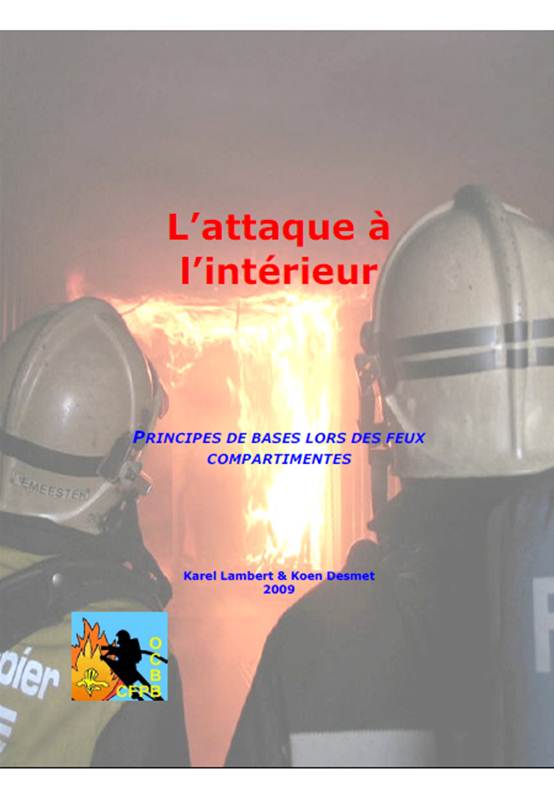"De warmtebeeldcamera" is a text that was written in 2009 with the introduction of thermal imaging cameras of the type "FireFlir" in the Brussels Fire Department. The text is nothing more than a manual that describes the possibilities of the tool. The text is available in Dutch and French.
De warmtebeeldcamera La Caméra thermique
In 2010 the Belgian federal government started a project to study the COBRA system. Members of the committee were 1Lt Jean-Claude Vantorre (Knokke-Heist FD), 2Lt Karel Lambert (Brussels FD), 1Lt Emmanuel Belaire (Liege FD) en Cdr Dirk Verschueren (Antwerpen FD). This group wrote two reports.
cobra_deel1_NL.pdf cobra_eindrapport_NL.pdf
Karel Lambert wrote the work "Binnenbrandbestrijding, basisprincipes bij compartimentsbranden" together with Dr. Koen Desmet. It was used by several fire academies (West-Vlaanderen, Vlaams-Brabant, Limburg and Brussels) to support the CFBT training. it is available in Dutch and French and has been printed three times.


In the framework of the Postgraduate studies in Fire Safety Engineering at Ghent University, Karel Lambert wrote a thesis about the use of positive pressure fans in staircases. The goal was to determine the ideal position of one or more fans. The results of the thesis have been presented in the article "configuring power blowers". Readers who want a more in-depth knowledge can read the complete thesis (in Dutch).
After the postgraduate studies, Karel Lambert started the International Master of science in Fire Safety Engineering (IMFSE). For the course "explosions and industrial safety", he wrote a paper about backdraft (in English).
LAMBERT_backdraft.pdf LAMBERT_Backdraft_FR
In a short paper about health effects of CFBT, Karel Lambert describes the measures that can be taken to protect participants and instructors:
Karel Lambert has written a master thesis about the use of positive pressure fans in subway stations. In this work CFD calculations are compared with full scale experiments to determine if PPV fans can contribute to the work of the fire service (in English).
Karel Lambert wrote a handbook about the use of hoses in coils. This has been written for the Brussels fire service. It can be used as a source of inspiration for other fire services because a number of important details when working with coils is independent of the number of firefighters on the engine.
syllabus_bundels_v1.1_NL.pdf syllabus_bundels_v1.1_FR.pdf
Changes to the building environment force the fire service to use new tactics and new tools. Piercing nozzles are one example of new tools that are used by the fire service. Lots of information about the benefits of piercing nozzles can be found in the handbook below.
piercing_nozzles_v0.2_NL.pdf piercing_nozzles_v0.2_FR.pdf
Asked by John McDonough, Karel Lambert wrote a short paper that explains how steam works as an extinguishing medium. Feedback is always welcome.
Steam as an extinguishing medium
There is a fairly easy formula to calculate the heat release rate of a fully developed fire that is venting through only one opening (e.g. a door). The heat release rate is then 1500 times the surface of the opening times the square root of the height of that opening. James Mendoza (US) and Lucas Garden (AUS) popped the question if it was also possible to come up with a formula to calculate what happens if there is a window and a door opening. Karel Lambert gave it a try and wrote a paper with a mathematical approach to this problem.
Scientific paper
Together with prof Bart Merci (Ghent University), Karel Lambert wrote a scientific paper about his postgraduate thesis. The paper was submitted with Fire Technology, a scientific peer reviewed journal. In such journals, the copyrights of the paper are transferred to the publisher of the journal. This is why the paper can't be downloaded for free. Most universities have subscriptions for these journals. Students can download these papers for free via the library.
The link to the paper: http://link.springer.com/article/10.1007/s10694-013-0359-0


